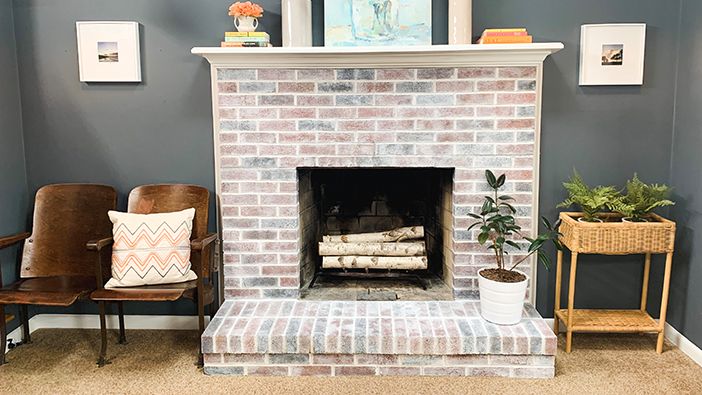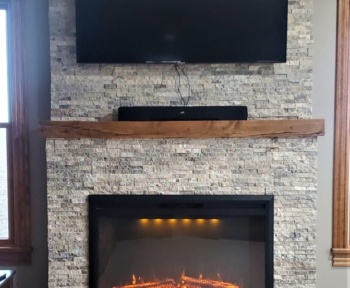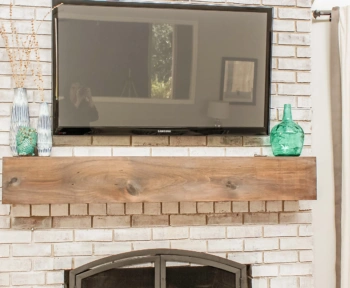A brick fireplace is a classic home feature, but it can be tricky to keep clean. Whitewashing your brick fireplace is a great way to brighten up the room and give it a fresh look. Here are some tips on how to whitewash your brick fireplace:
First, you need to gather your supplies. You will need white paint, a brush, and some rags. Make sure to use a paint that is specifically made for bricks or masonry surfaces.
Once you have your supplies ready, start by painting a small section of the fireplace with the white paint. Work in small sections and make sure to evenly coat the bricks.
- Gather your materials
- You will need a bucket of water, a sponge, a brush, and some white paint
- Wet the brick with the sponge, making sure to evenly soak the entire surface
- Apply the paint with the brush, using long strokes in one direction
- Be sure to work the paint into all of the nooks and crannies of the brick for full coverage
- Allow the paint to dry completely before using the fireplace again
HOW TO WHITEWASH A BRICK FIREPLACE | DIY MANTLE
How to Whitewash Brick With Chalk Paint
There’s something so warm and inviting about a whitewashed brick wall. It has a rustic charm that can make any space feel cozy and inviting. And the best part is, it’s easy to do yourself with some chalk paint and a little elbow grease!
Here’s how to whitewash brick with chalk paint: 1. Start by painting your bricks with a base coat of chalk paint. This will help the whitewash adhere better and provide even coverage.
2. Once the base coat is dry, mix up your whitewash mixture. You can use equal parts water and white vinegar, or milk and lime juice. Add in some salt to help the mixture thickened and clings to the bricks better.
3. Using a brush or sponge, apply the whitewash mixture to the bricks in long strokes. Work in small sections so that you don’t get too much wet paint on the surrounding areas. 4 .
Allow the whitewash to dry for at least an hour before touching it up or adding another layer for more coverage.
What Kind of Paint Do You Use to Whitewash Brick
Whitewashing is a popular painting technique that can give any room a fresh, new look. But what kind of paint should you use to whitewash brick? There are two main types of paint you can use for whitewashing: latex and oil-based.
Latex paint is water-based and easier to clean up, while oil-based paint provides better coverage and durability. However, either type of paint will work well for whitewashing. When choosing a paint color, keep in mind that lighter colors will be more transparent and allow the brick texture to show through more than darker colors.
You can also add a little bit of pigment to your white paint to create a custom color. Just be sure to test it out on a small area first before committing to the whole wall! Once you’ve chosen your paint, mix it with an equal part of water in a bucket.
Then, using a brush or roller, apply the mixture evenly to the surface of the brick. Start at the top and work your way down, taking care not to miss any spots. After the first coat dries completely (which may take several hours), apply a second coat if necessary.
Once both coats are dry, enjoy your newly whitewashed brick wall!
What Kind of Paint Do You Use to Whitewash a Brick Fireplace?
There are a few different types of paint you could use to whitewash a brick fireplace, but latex paint is generally the best choice. You’ll want to use a semi-gloss or high-gloss finish for the most durable and easy-to-clean surface. To get started, mix your paint with water in a 1:1 ratio and apply it to the bricks with a brush or roller.
Work in small sections and be sure to evenly coat all of the bricks. Once the first coat is dry, apply a second coat if necessary.
Is Whitewashing Brick a Good Idea?
Whitewashing brick is a popular way to update the look of a home, but it’s not without its drawbacks. Here are some things to consider before whitewashing your brick: 1. The type of brick.
Some bricks are more porous than others and will absorb more whitewash, resulting in a lighter color. If you’re not sure what type of brick you have, it’s best to test the whitewash on a small area first to see how it will turn out. 2. The condition of the brick.
Bricks that are in good condition with few cracks or chips will take the whitewash better than those that are damaged or crumbling. It’s important to repair any damage before whitewashing so that the finish will be even and smooth. 3. The weather conditions.
Whitewashing should only be done on a sunny day when the temperature is above 50 degrees Fahrenheit (10 degrees Celsius). This ensures that the bricks are warm enough to absorb the whitewash and that they won’t be damaged by cold weather during the drying process. 4. The method used for applying whitewash.
There are two main ways to apply whitewash: brush-on and spray-on. Brush-on is the traditional method and gives you more control over how much coverage you get, but it can be messy and time-consuming.
Do You Need Special Paint to Whitewash Brick?
Whitewashing brick is a popular trend these days, and for good reason! It’s an easy and inexpensive way to update the look of your home. But before you start painting, there are a few things you need to know.
First, whitewash is best applied to bare or unpainted brick. If your brick has been previously painted or sealed, you’ll need to remove that old coating before applying whitewash. This can be done with a wire brush or power washer.
Once the surface is clean and dry, you’re ready to begin painting. There are two types of paint you can use for whitewashing: latex or oil-based. Latex paint is easier to work with and cleanup, but it doesn’t adhere as well to unsealed surfaces like brick.
Oil-based paint will give you better coverage and durability, but it’s more difficult to apply and cleanup. Whichever type of paint you choose, be sure to get a white primer as well – this will help the whitewash color really pop! Once you’ve gathered your supplies, mix up your whitewash mixture according to the recipe (you can find many online).
Then get started painting! A word of caution: Whitewash dries quickly, so work in small sections and don’t try to fix any mistakes – they’ll only stand out more once the paint dries!
Should I Paint Or Whitewash My Brick Fireplace?
If you have a brick fireplace that you’re considering painting or whitewashing, there are a few things to keep in mind. First, think about the overall look you’re trying to achieve in your space. If you want a more modern look, painting the fireplace may be the way to go.
If you’re going for a more rustic feel, whitewashing might be best. Another thing to consider is the condition of your bricks. If they’re in good shape and don’t have any major cracks or damage, painting or whitewashing should be no problem.
However, if your bricks are damaged or crumbling, it’s best to leave them as-is and not try to cover up the damage with paint or Whitewash. Finally, think about maintenance. Both painting and whitewashing will require some upkeep over time – touch ups here and there as needed.
So if you’re not willing to put in the work to maintain your fireplace, it’s probably best to leave it as-is. All things considered, there is no right or wrong answer when it comes to whether or not you should paint or whitewash your brick fireplace. It all comes down to personal preference and what look you’re going for in your space!
Conclusion
Whitewashing a brick fireplace is a simple and effective way to achieve a charming look. The process is relatively straightforward, and the results can transform the entire feel of a room. In order to whitewash your brick fireplace, you will need some supplies including white paint, water, sponges, and rags.
Once you have gathered your materials, start by mixing the paint with water in a ratio of 1:1. Next, use a sponge to apply the mixture evenly over the surface of the bricks. Be sure to work in small sections so that the paint does not dry before you have a chance to spread it around.
Finally, use a clean rag to remove any excess paint from the bricks and allow them to dry completely before enjoy your newly updated fireplace!




